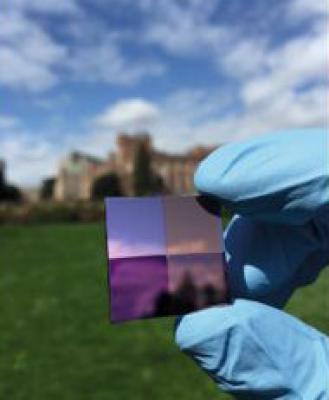Researchers at the University of Washington report that a prototype perovskite thin-film has performed even better than today's best solar cell materials at emitting light. 'It may sound odd since solar cells absorb light and turn it into electricity, but the best solar cell materials are also great at emitting light,' said co-author and UW chemical engineering professor Hugh Hillhouse. 'In fact, typically the more efficiently they emit light, the more voltage they generate.'
 a back-reflector A back-reflector surface used to test perovskite performance. Each quadrant is a different surface material ' gold, titanium, palladium or a silica compound ' upon which the perovskite material would be deposited for experiments
a back-reflector A back-reflector surface used to test perovskite performance. Each quadrant is a different surface material ' gold, titanium, palladium or a silica compound ' upon which the perovskite material would be deposited for experiments
The UW team achieved a record performance using a lead-halide perovskite, by chemically treating it through a process known as 'surface passivation,' which treats imperfections and reduces the likelihood that the absorbed photons will end up wasted rather than converted to useful energy.
Ginger's and Hillhouse's teams worked together to demonstrate that surface passivation of perovskites sharply boosted performance to levels that would make this material among the best for thin-film solar cells. They experimented with a variety of chemicals for surface passivation before finding one, an organic compound known by its acronym TOPO, that boosted perovskite performance to levels approaching the best gallium arsenide semiconductors.
'Our team at the UW was one of the first to identify performance-limiting defects at the surfaces of perovskite materials, and now we are excited to have discovered an effective way to chemically engineer these surfaces with TOPO molecules,' said co-lead author Dane deQuilettes, a postdoctoral researcher at the Massachusetts Institute of Technology who conducted this research as a UW chemistry doctoral student. 'At first, we were really surprised to find that the passivated materials seemed to be just as good as gallium arsenide, which holds the solar cell efficiency record. So to double-check our results, we devised a few different approaches to confirm the improvements in perovskite material quality.'
DeQuilettes and co-lead author Ian Braly, who conducted this research as a doctoral student in chemical engineering, showed that TOPO-treating a perovskite semiconductor significantly impacted both its internal and external photoluminescence quantum efficiencies ' metrics used to determine how good a semiconducting material is at utilizing an absorbed photon's energy rather than losing it as heat. TOPO-treating the perovskite increased the internal photoluminescence quantum efficiencies by tenfold ' from 9.4% to nearly 92 percent%.
'Our measurements observing the efficiency with which passivated hybrid perovskites absorb and emit light show that there are no inherent material flaws preventing further solar cell improvements,' said Braly. 'Further, by fitting the emission spectra to a theoretical model, we showed that these materials could generate voltages 97% of the theoretical maximum, equal to the world record gallium arsenide solar cell and much higher than record silicon cells that only reach 84%.'
These improvements in material quality are theoretically predicted to enable the light-to-electricity power conversion efficiency to reach 27.9% under regular sunlight levels, which would push the perovskite-based photovoltaic record past the best silicon devices.
The next step for perovskites, the researchers said, is to demonstrate a similar chemical passivation that is compatible with easily manufactured electrodes ' as well as to experiment with other types of surface passivation.
'Perovskites have already demonstrated unprecedented success in photovoltaic devices, but there is so much room for further improvement,' said deQuilettes. 'Here we think we have provided a path forward for the community to better harness the sun's energy.'

